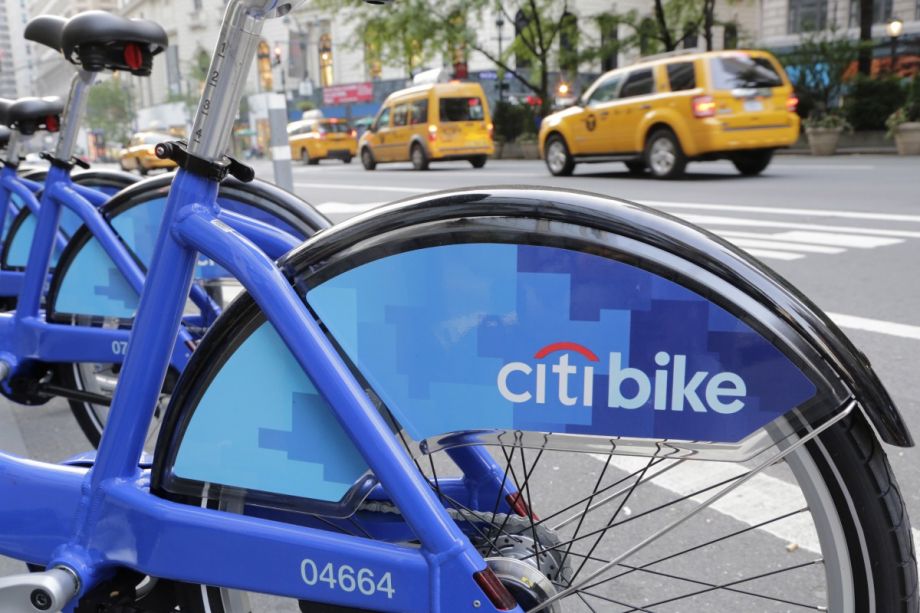Last night at NYU, there was a celebration and examination of Citi Bike data, the system’s second such event in its short life, and a demonstration of both why data enthusiasts are attracted to New York City’s bike-share data and why the system’s organizers and advocates are eager to cultivate that interest, pumping out, as of late March, granular monthly data on each ride taken on a Citi Bike. It’s one of the somewhat overlooked benefits of open public data: It doesn’t hurt to get the geeks involved and invested in your long-term survival.
And so, you had several dozen people on the second floor of NYU’s Puck Building on a weeknight, sitting around over prosciutto, melon and beers either showcasing what they’ve done or watching others do their demos, one in an expected series of what Noel Hidalgo, of BetaNYC, called “iterative nights.” The common mission: to help New York City improve how it moves. “This,” said Hidalgo, “is an inflection point in how we improve the safety and security of New York City, and how we improve its infrastructure, making it better to get around this really diverse city.”
Much of what was being shared was playful, or at least in the spirit of open discovery. Ben Wellington of I Quant NY (you might recall his map of New York’s most late-owlish Citi Bike stations) used the data to figure out the busiest Citi Bike bike in the city. It’s #17279, and between July and February it was docked at a whopping 86 percent of the 330 stations in the system. Meanwhile, information designers Alex Chohlas-Wood and Jeff Ferzoco hunted in the data for instances of “salmoning,” or riding against traffic, by looking at where riders were traveling between paired stations on 8th and 9th Avenues in Manhattan significantly faster than the median, presumably by going the wrong way. Or maybe not. They’re still digging.
“Part of the was exploration was that if we don’t find salmoning, we’re going to find something else,” said Ferzoco. “We just kinda want to know what the hell is going on.”
There were, too, substantive examinations more central to helping the system get traction. Citi Bike is eager to encourage more tourist use of the system, and Wellington pointed out that the data show that trips by so-called “casual users” are especially, unsurprisingly, high by the Hudson River, but stations there are few and far between. There was talk about upping the number of women riders — it’s at less than a quarter today among pass-holders, said Sarah Kaufman of NYU’s Rudin Center on Transportation. Expanding deeper into the outer boroughs might help, especially when it comes to Brooklyn: The numbers reveal that some 70 percent of all trips taken by women happen there.
Dani Simons is the director of marketing for New York City Bike Share, Citi Bike’s operator, and she told the crowd that data is core, too, to the system’s day-to-day operations, like how real-time pinging of system docking numbers can reveal a “stale heartbeat,” or a station completely offline. And it’s prompting them to innovate. What they’ve learned about redistributing bikes, especially during the critical morning and evening rush hours, is informing how they’ll do it going forward. “Moving bikes by bikes” is proving successful, so much so that they’re experimenting with heavy-duty tricycles that can ferry at least a half dozen bikes, often more nimbly than a box truck can move. (Though try salmoning with that thing.)
And they’re reaching out, including on some of the system’s stickiest problems. Citi Bikes’ software and hardware interfaces can be rage-inducing. They’ve been working with students studying interface design at the School of Visual Arts (SVA). The goal is in large part to reduce the sort of friction that can occur when you attempt to put your credit card in and generate a printed code to unlock a bike, all under the watchful gaze of those in line behind you. Sometimes it works. Sometimes it doesn’t. And it’s impossible to know which experience you’ll have until you try.
“We’re trying to hack the user experience of Citi Bike,” said Luke Stern, who presented alongside his fellow SVA student Amy Wu. Their research team has mocked up a system that would allow casual users to pre-pay away from the maddening crowds, either online or by mobile phone, by accessing a wider variety of passes than currently exist — a $2 single-ride pass, or a $15 Weekend Pass, good for three days. (Here’s a peek at their work.)
Simons was asked about Citi Bike’s oft-questioned financials, especially the bankruptcy of Bixi, its supplier, earlier this year. “We’re figuring it out,” she said, throwing in a joke that, “the headline-writers in New York are profiting immensely from our system.”
But this was a night for data demos, not a discussion of the challenges that Citi Bank faces in figuring out how to exist as a sort of quasi-public form of transportation. That said, Simons was willing to share a few details on where Citi Bike goes from here. The next phase of expansion will likely cover Williamsburg, Greenpoint and Long Island City, she said, followed by the Upper East Side, Upper West Side, Crown Heights and Park Slope. “We do not have a timeline yet,” she said. “I know, I know.” They need some time, was the point, and every indication is that they earn a bit more of it for themselves when they bring the community along for the ride.

Nancy Scola is a Washington, DC-based journalist whose work tends to focus on the intersections of technology, politics, and public policy. Shortly after returning from Havana she started as a tech reporter at POLITICO.
















